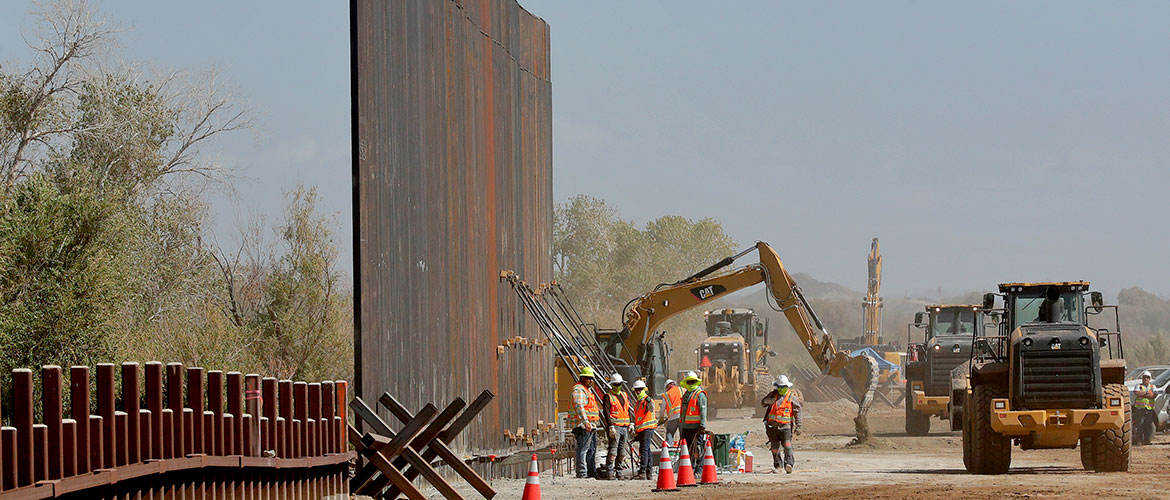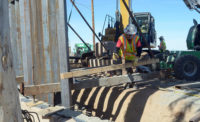The U.S. Supreme Court on Oct. 19 agreed to hear an appeal of a lower court’s finding that it is illegal for billions of dollars in military construction funds to be diverted to build sections of the U.S.-Mexico border wall—a move that now allows work in four states to continue until justices rule on the dispute, likely not until next year.
The high court's decision follows through on its ruling last year in the funding diversion dispute, when it refused to overturn a lower court's order allowing work to continue—at that time stating that if justices chose to review the funding challenge by environmental group opponents, there would be no change in construction status until after a final ruling on merits of the case is made.
The Supreme Court did not issue any explanation of its decision, which followed an Oct. 9 ruling by the U.S. appeals court in San Francisco that it is illegal for the Trump Administration to divert funds congressionally authorized for milcon projects to border wall building. The U.S. Defense Dept. had moved $3.6 billion in such funds to build 11 wall projects totaling 175 miles after President Donald Trump issued an emergency order in 2019 to enable the transfer when Congress failed to authorize $5.7 billion the White House sought.
Barrier projects "are neither necessary to support the use of the armed forces, nor are they military construction projects,” appellate court Judge Sydney Thomas said, citing the wall projects as civilian law enforcement related.
The high court's involvement now makes moot dueling efforts by the administration and by plaintiff Sierra Club for more clarity from the appeals court on whether construction would continue or halt.
The appellate court ruling follows an August decision by the Washington, D.C., appeals court that said the House of Representatives could sue the administration over the funding diversion, reversing a lower court. But a July ruling, again by the San Francisco appeals court, which said the fund transfer was unconstitutional, was stopped from taking effect by the Supreme Court in a September decision.
Contracts Awarded and Challenged
The latest legal scuffle comes as work ramps up to meet a Trump Administration political priority but also amid other legal actions and scrutiny of building activity, as well a likely construction halt if Democrat Joe Biden is elected president next month and takes office in January.
Work under two new federal border wall construction contracts in and near Laredo, Texas, is set to start next year, the U.S. Customs and Border Protection agency said Sept. 30, if there's “availability of real estate.”
But landowners along the state's largely open boundary with Mexico are accelerating legal and grassroots efforts to ensure the mostly private parcels are never available to the federal government, by either sale or seizure.
The newest CBP contracts, awarded in partnership with the U.S Army Corps of Engineers, are a 27-mile section to Fisher Sand & Gravel valued at $283 million, and a 13-mile, $201.2-million segment to Southwest Valley Constructors, a division of Kiewit.
The agencies set a next September start date for construction with funding for both from CBP's fiscal 2020 budget.
Meanwhile, current Southwest Valley wall work in Hidalgo County, Texas, appears to be halted after a state judge issued a temporary restraining order Sept. 30 in a lawsuit filed by owners of an adjacent private church and cemetery that claimed damage from construction and heavy equipment movements and vibrations.
The order bars the company from any construction activity within 100 ft of the state historic site, while the lawsuit moves to federal district court in southern Texas for a decision on a final decision.
Illlegal Dumping?
The Corps also is investigating a complaint that Southwest Valley or its subcontractors are dumping demolition debris and construction materials in Mexico from wall work at the Organ Pipe Cactus National Monument in Arizona, which is believed to be illegal.
The agency has not completed its investigation and could not confirm or release details related to the allegations, Corps spokeswoman Raini Brunson told ENR. CBP did not return a request for comment.
The existing wall at the site is being demolished and replaced with 30-ft. bollards. According to local news reports, Mexicans had asked construction workers to illegally dump the debris and materials across the border where they retrieve it for sale in Mexico, with scrap metal from old fencing worth about 75 cents per kilogram.
Southwest Valley has two contracts—one valued at $102 million to replace five miles of 18-ft-high wire mesh fencing and a second valued at $789 million to replace 38 miles of 6-ft-high vehicle barriers.
Fighting Eminent Domain
In Laredo, population 262,000, the city council voted Oct. 5 to refuse right of entry to its land for the just-awarded Southwest Valley Constructors contract.
The International Border and Water Commission also seeks a trial date in a legal action against Fisher Sand & Gravel linked to a crumbling section of privately-funded wall the contractor built this year on the banks of the Rio Grande near Mission, Texas, IBWC foreign affairs officer Sally Spener told ENR. The agency is the river's bi-national manager.
The congressional Homeland Security Committee also awaits delivery of a DOD inspector general audit begun last December of how Fisher Sand & Gravel won a $400-million federal border wall construction contract, the first of four the company has landed to date.
“The administration should pause construction and contracting decisions until the investigation has concluded,” says Rep. Bennie Thompson, a Mississippi Democrat who chairs the committee. A spokesman could not say when the analysis will be complete.
Weighing Costs
Ricardo De Anda, a local attorney representing Laredo landowners, said the area's wall opposition effort picked up following campaign comments by former Vice President and Democratic presidential candidate Joe Biden that land seizures and wall construction would stop if he were elected.
Most land along the Rio Grande is private or municipally owned.
The federal wall along most of the Texas border is being built up to three miles inland from the Rio Grande on a levee and away from the river flood plain. De Anda claims the location "defeats the purpose" of the barrier program because it would allow non-citizens crossing the river to reach U.S. soil and seek asylum.
Landowner lawyers have a joint defense strategy against current government land seizures. “We have a legal argument and hope to short circuit attempts until after the election,” says De Anda.
No parcel in the Laredo sector has yet been taken, he says. But in one specific case, the U.S. asked the federal court in Laredo to order a property owner to immediately surrender a portion of a 127-acre parcel so engineers could begin land surveying. The action was brought at the request of the Secretary of Homeland Security, the lawsuit said.
There are dozens of landowners actively pursuing legal action to stall property takeover and hundreds not yet sued by the U.S. attorney for survey rights, De Anda says. Many are asking the court to require the government to appraise property to determine reasonable payment.
Seeking Appraisals
Related to the two new Laredo building contracts, Tricia Cortez, co-founder of the Laredo No Border Wall Coalition and executive director of the Rio Grande International Study Center, told ENR: “The wall is not rooted in sound immigration, national security or drug policy. It is for political gain."
CBP also had awarded Fisher Sand & Gravel a $289.5-million contract on Aug. 3 to build 17 miles of barrier through Laredo, which includes a bulkhead to replace the downtown riverbank.
According to Cortez, the bulkhead apparently is a seawall and has an elevated platform with metal fencing on top, although CBP has not released maps, renderings or environmental reports to the public.
“There is a reason they don’t want the public to see the magnitude of their plans, clearing 150 feet of riverbank, with roads and surveillance towers and a 30-ft wall,” she says.
CBP also is testing the use of black coating on about 82 miles of wall in Laredo and nearby counties that could add $1-million per mile to construction costs, the agency says.
Agency data shows Laredo is ranked seventh out of its nine border sectors in illegal border crossings, according to Cortez. “We’re not in a crisis, but they still want to come in here ... with nothing to justify their move,” she says.





